Life Processes - Revision Notes
CBSE Class 10 Science
Revision Notes
CHAPTER – 6
LIFE PROCESSES
- All living things perform certain life processes like growth, excretion, respiration, circulation etc.
- The basic functions performed by living organisms for their survival and body maintenance are called life process.
Basic life processes are : Nutrition, Respiration, Transportation, Excretion etc.
Life Processes require energy which is provided by nutrition.
Modes of Nutrition
- Autotrophic :-Kind of nutrition in which organisms can synthesize their own food Eg. Green Plants
- Heterotrophic:- Kind of nutrition of which organisms do not possess the ability to synthesize their own food. They depend on autotrophs for their food supply directly or indirectly. Eg. Animals, Fungi
Autotrophic Nutrition
- Autotrophs : The organisms which can make their own food are called autotrophs (green plants).
- Photosynthesis : The process by which green plants make their own food with the help of CO and H O in the presence of chlorophyll and sunlight is also called photosynthesis.
- Raw Materials for Photosynthesis :
- Site of Photosynthesis : Chloroplast in the leaf. Chloroplast contain chlorophyll. (green pigment).

- Main Events of Photosynthesis
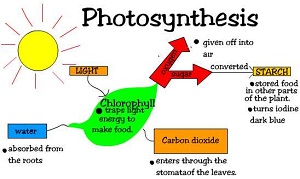
Absorption of Sunlight energy by chlorophyll
to carbohydrates.
- Stomata : Tiny pores present on the surface of the leaves.
- Functions of Stomata
- (i) Exchange of gases
- (ii) Loses large amount of water [water vapour] during transpiration and helps in up flow of water
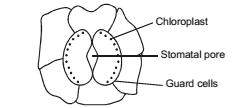
Chloroplast contains the green pigment chlorophyll which has a pivotal role in photosynthesis.
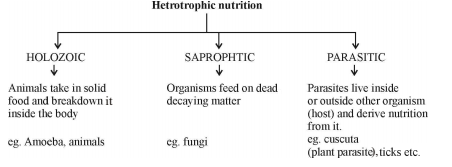
- Nutrition in Animals

- Nutrition in Amoeba
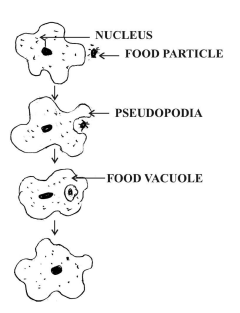
Amoeba has a holozoic nutrition. Thus, solid food particles are ingested which react with enzymes and are digested. It is an omnivore.
(i) Amoeba move with the help of pseudopodia (extension of cell membrane)
(ii) Food vacule is formed
(iii) Undigested food is thrown out.
- Nutrition in Human Beings : The human digestive system comprises of alimentary canal and associated digestive glands.
HUMAN DIGESTIVE SYSTEM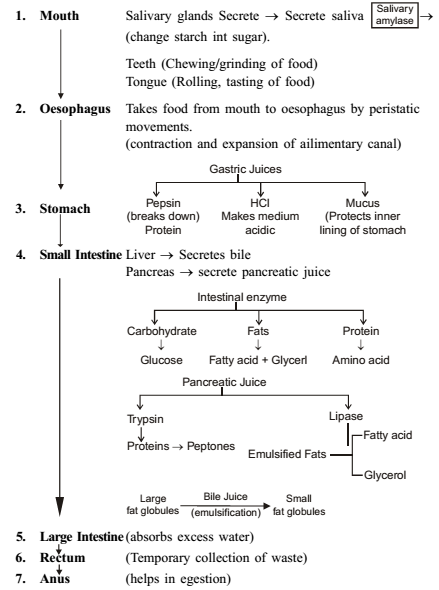
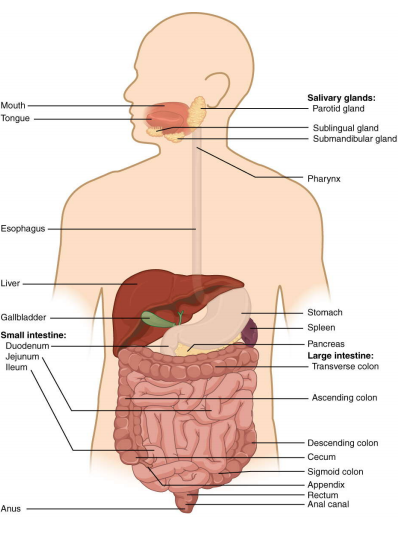
HUMAN DIGESTIVE SYSTEM: As shown in the flow chart, digestion begins from th mouth.In the mouth it is broken down by salivary amylase. The food moves to the stomach through the oesophagus which performs persistatic movement. Enzymes and various digestion juices from liver,gall bladder and pancreas act on the chunks from the stomach in the small intestine. In the large intestine , the remaining nutrients are absorbed and the leftover is removed from the body through the rectum and anus.
Respiration
It is a process in living organisms involving the production of energy, typically with the intake of oxygen and the release of carbon dioxide from the oxidation of complex organic substances.
(i) Gaseous exchange : Intake of oxygen from the atmosphere and release of carbondioxide.
(ii) Breakdown of simple food in order to release energy inside the CellularRespiration
- Breakdown of Glucose by various pathways
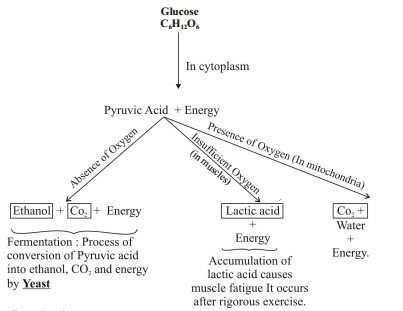
- Respiration
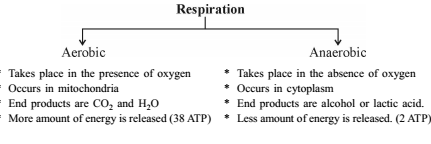
- Human Respiratory System : Passage of air through the respiratory system.
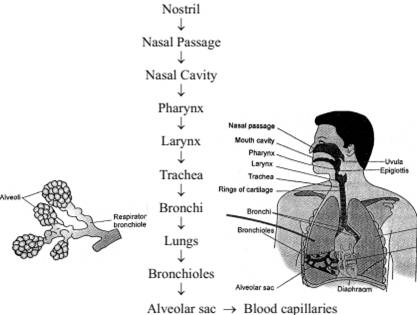
- Mechanism of Breathing
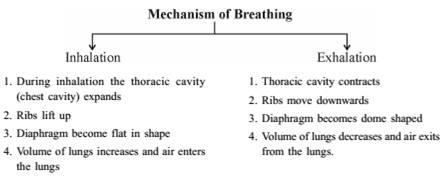
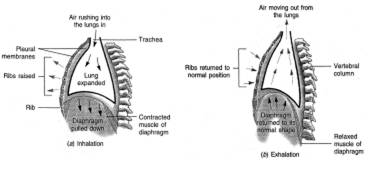
- Exchange of Gases between alveolus, blood and tissues.
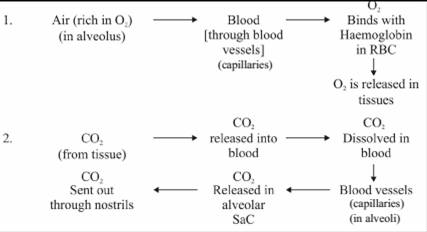
- Terrestrial Organism – use atmospheric oxygen for respiration
- Aquatic Organisms – use oxygen dissolved in water.
- Respiration in Plants : Respiration in plants is simpler than the respiration in animals. Gaseous exchange occur through
1. Stomata in leaves
2. Lenticels in stems
3. General surface of the roots.
Transportation
- Human beings like other multicellular organism need regular supply of food, oxygen etc., This function is performed by circulatory system or Transport system.
- The circulatory system in human beings consists of :
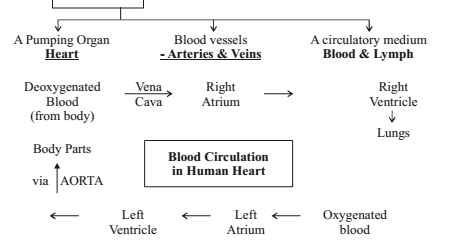
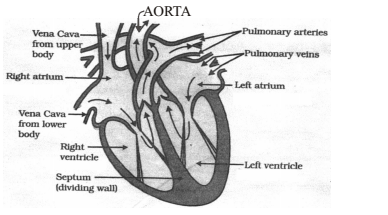
Section view of the Human Heart
- Double Circulation : Blood travels twice through the heart in one complete cycle of the body.
- Pulmonary circulation : blood moves from the heart to the hugs and back the heart.
- Systemic circulation :blood moves from the heart to rest of the body and back to the heart.
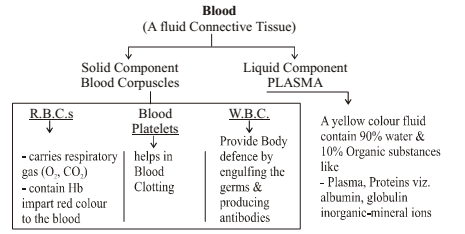
- Lymph - a yellowish fluid that escapes from the blood capillaries into the intercellular spaces. Lymph flows from the tissues to the heart assisting in transportation and destroying germs.
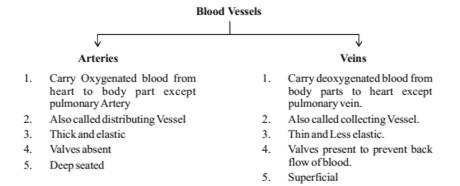
- Transportation in Plants : There are two main conducting tissues in a plant.
(a) Xylem (b) Phloem.
- Transpiration is the process by which plants lose water in the form of vapours.
- Role of Transpiration
1. Absorption and upward movement of water and minerals by creating PULL.
2. Helps in temperature regulation in Plant. - Translocation : Transport of food from leaves (food factory) to different part of the plant is called Translocation.
- Excretion in human beings : The process of the removal of the harmful metabolic wastes from the body is called excretion. Excretory system of human beings includes :
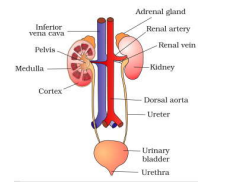
- A pair of kidney
- A Urinary Bladder
- A pair of Ureter
- A Urethera
- Process of Excretion
Renal artery bring in blood containing waste substances to the kidneys.
Kidney filters blood.
Urine produced in the kidneys passes through the ureters into the urinary bladder where it is stored until it is released through the urethera. - Function of Kidney : It is remove waste product from the blood i.e., urea which is produced in the liver.
- Nephron : Each kidney has a large number of filtration units called nephrons.
Nephron is the structural and functional unit of Kidney.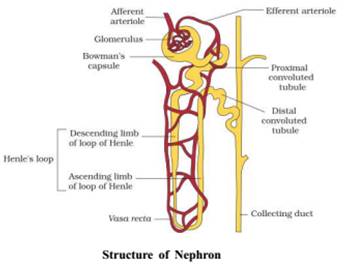
- Mechanism of Urine Formation : The Urine formation involves three steps:
- Glomerular Filtration : Blood is filtered from the glomerulus into Bowman Capsule of the nephron. This filtrate passes through the tubules of the nephron.
- Tubular re-absorption : Now, useful substances from the filtrate Like , glucose, amino acids etc. are reabsorbed by the capillaries surrounding the nephron into the blood.
- Secretion : Urea, extra water and salts are secreted into the tubule which open up into the collecting duct & then into the ureter.
- Haemodialysis: The process of purifying blood by an artificial kidney. It is meant for Kidney failure patient.
Excretion in Plants
1. Oxygen released during photosynthesis.
2. by transpiration
3. Wastes may be stored in leaves, bark etc. which fall off from the plant.
4. Waste products stored as gums, resin in old Xylem
5. Plants excrete some waste into the soil around them.
What you have learnt
- Movement of various types can be taken as an indication of life.
- The maintenance of life requires processes like nutrition, respiration, transport of materials within the body and excretion of waste products.
- Autotrophic nutrition involves the intake of simple inorganic materials from the environment and using an external energy source like the Sun to synthesis complex high-energy organic material.
- Heterotrophic nutrition involves the intake of complex material prepared by other organisms.
- In human beings, the food eaten is broken down by various steps along the alimentary canal and the digested food is absorbed in the small intestine to be sent to all cells in the body.
- During the process of respiration, complex organic compounds such as glucose are broken down to provide energy in the form of ATP. ATP is used to provide energy for other reactions in the cell.
- Respiration may be aerobic or anaerobic. Aerobic respiration makes more energy available to the organism.
- In human beings, the transport of materials such as oxygen, carbon dioxide, food and excretory products is a function of the circulatory system. The circulatory system consists of the heart, blood and blood vessels.
- In highly differentiated plants, transport of water, minerals, food and other materials is a function of the vascular tissue which consists of xylem and phloem.
- In human beings, excretory products in the form of soluble nitrogen compounds are removed by the nephrons in the kidneys.
- Plants use a variety of techniques to get rid of waste material. For example, waste material may be stored in the cell-vacuoles or as gum and resin, removed in the falling leaves, or excreted into the surrounding soil.
